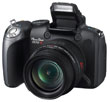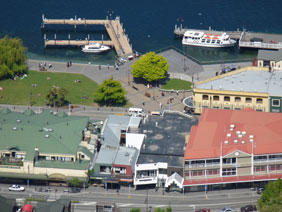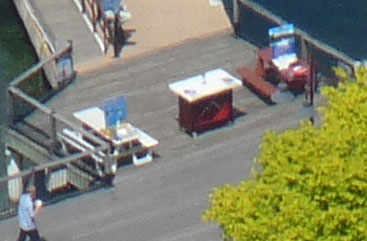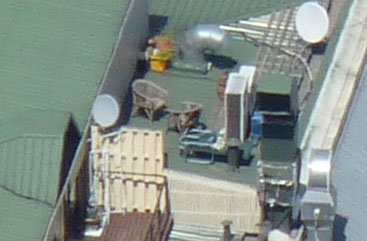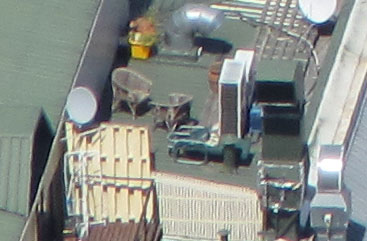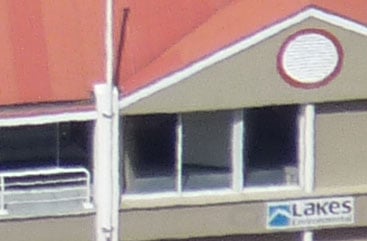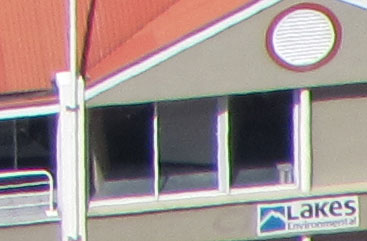Panasonic Lumix DMC-FZ28
-
-
Written by Gordon Laing
Panasonic FZ28 vs Canon PowerShot SX10 IS vs EOS 450D / XSi outdoor scene
Panasonic Lumix FZ28 vs Canon PowerShot SX10 IS outdoor scene telephoto
Note: as above, both the Panasonic FZ28 and Canon SX10 IS were in Program mode, where this time they automatically selected apertures of f7.1 and f5.7 respectively. This once again raises concerns over diffraction on the FZ28, but see our note at the top of this page. First things first: the composition above was taken from the same location as our first shot at the top of the page, albeit with the cameras tilted down a little. It illustrates the enormous optical range you have at your disposal with both cameras, taking you from decent wide angle to super-telephoto capabilities. The question though is whether the quality is compromised as a result. Below we’ve compared crops taken from each camera zoomed-into their maximum focal lengths of 486mm for the Panasonic and 560mm for the Canon. With the longer focal length, the SX10 IS crops show a smaller area. We chose not to match the field of view here, instead wanting to see how each compared when fully zoomed-in. Analysis of the crops below essentially results in a repeat of those above: the FZ28’s crops exhibit impressively low fringing (due to in-camera processing as explained above), but are marred by softness and a fine texture of noise which becomes more obvious if you increase the sharpening. In contrast, while the SX10 IS exhibits greater coloured fringing around high contrast areas in the corners, it enjoys crisper, cleaner details. But to be fair both cameras are still delivering very respectable results here given their extreme zoom ranges. Given the often disappointing quality of earlier super-zooms, it’s impressive just how good they’ve now become. Now scroll down further to see a comparison of the FZ28 at f4.0 and f5.6 to see if diffraction is an issue at these settings when shooting real-life subjects, followed by a RAW versus JPEG comparison.
|
Panasonic Lumix DMC-FZ28: detail at f4.0 and f5.6
The examples above show the FZ28 automatically selecting smaller apertures than the Canon when faced with the same scene in its Program mode, due to a reluctance to use shutter speeds faster than 1/500 unless in extreme circumstances; coincidentally the FZ18 did exactly the same thing. Since this first page of results is designed to compare how the automatic modes on each camera evaluate the same scene, we’ve stuck with the default settings for our main discussion here. Diffraction and subsequent loss of fine detail is however an issue at smaller apertures, and the settings selected by the FZ28 here were operating close to its minimum of f8. As explained above, this is due to the camera’s Program line which tends to avoid shutter speeds faster than 1/500 in Program unless it absolutely has to – so when faced with a bright scene at its lowest ISO, it has no choice but to close the aperture. Indeed we have two examples in our Gallery where the FZ28’s Program mode actually chose f8 at 1/400 and 1/500, rather than f5.6 at 1/800 or 1/1000. While this is an odd decision by Panasonic’s engineers when setting the Program line for the FZ28 (compared to the Canon which aims for larger apertures with quicker shutters if it’s bright), it does of course beg the question whether the Lumix could record greater detail at smaller f-numbers. So we reshot our standard outdoor scene with the FZ28 zoomed-out at every f-number in Aperture Priority mode to see. Below are crops taken from the samples at f4.0 and f5.6. There’s arguably a fractional improvement in fine detail on the f4.0 sample on the left (most obviously in the foliage areas), but it’s hardly a difference of night and day, and continues to show the FZ28 exhibiting an overall softness compared to the Canon SX10 IS. The quality does however drop significantly at f8, and worryingly we found the FZ28 (like the FZ18 before it) using this aperture several times under very bright conditions – see our Gallery for examples. Again to avoid this, you may need to manually choose larger apertures using Program Shift or Aperture Priority. While this first results page compares each camera in their automatic modes, we switch to Aperture Priority for our studio results on the next page to discover the optimum settings. But first scroll down a little further to see the FZ28’s RAW performance. |
Panasonic Lumix DMC-FZ28: f4.0 |
Panasonic Lumix DMC-FZ28: f5.6 | |
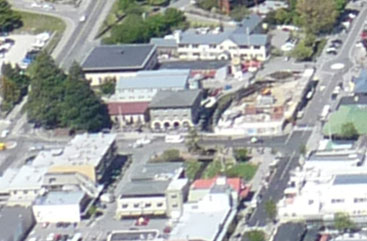 | 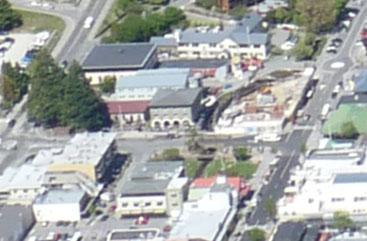 | |
f4, 100 ISO |
f5.6, 100 ISO |
Panasonic Lumix DMC-FZ28: JPEG versus RAW
We photographed the scene here in the Lumix FZ28’s RAW plus Fine JPEG mode, allowing us to directly compare images created from exactly the same data. Below are 100% crops taken from the original JPEG file alongside the RAW version, processed with the supplied Silkypix Developer Studio 3.0SE software using its default settings. As we’ve seen before with Silkypix, the default settings deliver softer results than the in-camera JPEGs, and the crop below also exhibits posterisation effects that give it a slightly unnatural, painted appearance. Silkypix does of course offer a wealth of adjustments though including the ability to tweak noise reduction and apply lens corrections. So while the result below is not particularly impressive, we’re still very pleased to find RAW on the FZ28 – it’s a key advantage over the SX10 IS, and as you’ll see on the next page it offers a small boost in ultimate resolution. And as always, you may achieve better results with alternative RAW development software. Now let’s look at the Lumix FZ28’s resolution in a studio environment. |
Panasonic Lumix DMC-FZ28: JPEG |
Panasonic Lumix DMC-FZ28: RAW | |
 |  | |
f5.6, 100 ISO |
f5.6, 100 ISO |
Panasonic Lumix DMC-FZ28 results continued…

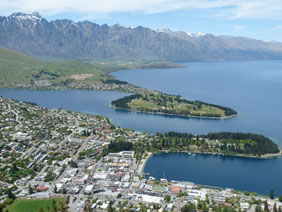 |
|
To compare real-life performance we shot the same scene with the Panasonic Lumix FZ28, Canon PowerShot SX10 IS and Canon EOS 450D / XSi within a few moments of each other using their best quality JPEG and lowest ISO settings. The lenses on each camera were adjusted to deliver the same vertical field of view. The image left was taken with the Panasonic Lumix FZ28 in Program mode at 6mm f5.6 and with a sensitivity of 100 ISO; the original Fine JPEG measured 2.34MB. The crops are taken from the upper left, center, lower right and lower left portions of the originals and presented here at 100%. |
Note the Canon 450D / XSi captures wider 3:2 aspect ratio images, so by matching the vertical field of view, we’re effectively treating the DSLR here as a 10.8 Megapixel camera, delivering 4:3 shaped images.
Note: both the FZ28 and SX10 IS were set to Program mode, where they automatically selected apertures of f5.6 and f4.0 respectively. Since this first test is designed to show how each camera’s Automatic modes evaluate the same scene under the same conditions, we used these default settings for the crops below. We do however appreciate diffraction is a concern for compacts at smaller apertures, so reshot the scene later in Aperture Priority mode at all settings. You can see a comparison showing the FZ28 at f4.0 and f5.6 lower down on this page. We also used Aperture Priority during our studio resolution tests to find the optimum f-number.
We should however mention we found the FZ28 opted for small apertures on several occasions in Program mode due to a reluctance to use a shutter speed faster than 1/500 under certain conditions. This was the case here where at 100 ISO and 1/500, it had nowhere to go but to close the aperture. You can of course manually over-ride and select a larger aperture with Program Shift or Aperture Priority, but again, this test is designed to compare the cameras without intervention.
Now to the comparison of the crops below. It’s clear from the first row of crops showing the mountain ridge in the upper left corner that both Canons are exhibiting much greater coloured fringing than the FZ28 – indeed the Panasonic is essentially bereft of any fringing here. We noticed this with the earlier FZ18, so decided to investigate further here. If you shoot the same scene in RAW and JPEG, you’ll find the FZ28’s RAW file does in fact exhibit roughly the same degree of fringing as the Canon SX10 IS; you can see an example of this on our Features page. So the FZ28 is applying digital correction to its JPEGs to eliminate the fringing, and it’s possible to also do so on its RAW files using Silkypix’s correction tools. So while the FZ28’s lack of fringing is down to digital correction rather than superior optics, there’s few who wouldn’t be pleased with the results. Indeed it’s disappointing Canon didn’t include correction of fringing in their latest DIGIC 4 processor, and by also not offering RAW files, the SX10 IS limits your options for subsequent correction.
Looking at the rest of the crops though, the PowerShot SX10 IS has the advantage over the Panasonic. One glance shows them to be cleaner and better defined – indeed the FZ28 crops viewed at 100% look almost as if a veil were in front of them. This isn’t an isolated case or a technical error. We repeated the test on different days and also compared the output at different apertures (see lower down this page), but in each case the FZ28’s images appeared softer than the Canon’s. The same effect can also be seen on other Panasonic models including the LX3 and FZ18 – their in-camera JPEGs are just lacking the bite of some rivals.
Now much of this is down to image processing, with the Canon SX10 IS applying greater sharpening and contrast for a punchier result. By doing the same to the FZ28’s images, you can begin to match the output seen below, but this in turn reveals greater background noise textures than its rival. Perhaps Panasonic keeps the sharpening relatively low to avoid this problem.
As for the DSLR, the 450D / XSi’s default output falls roughly between the two on sharpness and can certainly be boosted if preferred, but no processing can improve the softness seen in the lower right corner of images taken with our EF-S 18-55mm IS sample (as seen in the third row of crops).
Of course this test was with both super-zooms set to close to their widest focal lengths. Scroll down to see a second set of examples taken with both cameras fully zoomed-into their maximum focal lengths to compare them at their extremes. Below that you’ll find a comparison of the FZ28 at f4.0 and f5.6, and finally a RAW versus JPEG example. Alternatively if you want to skip straight to detail results taken in a more controlled environment, head on to our Panasonic Lumix DMC-FZ28 Studio Resolution page.
Panasonic Lumix DMC FZ28 |
Canon PowerShot SX10 IS |
Canon EOS 450D / Rebel XSi | ||
 |
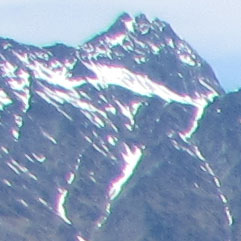 |
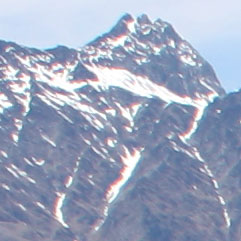 | ||
f5.6, 100 ISO |
f4, 80 ISO |
f8, 100 ISO | ||
 |
 |
 | ||
f5.6, 100 ISO |
f4, 80 ISO |
f8, 100 ISO | ||
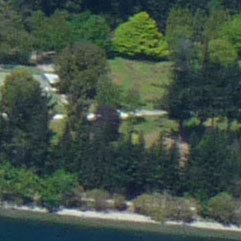 |
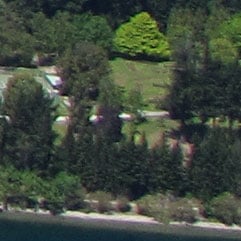 |
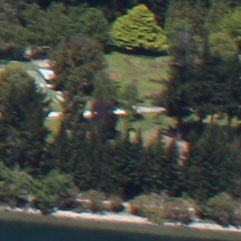 | ||
f5.6, 100 ISO |
f4, 80 ISO |
f8, 100 ISO | ||
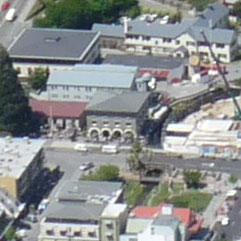 |
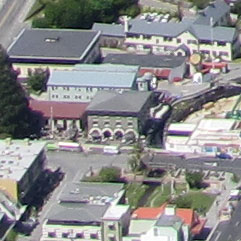 |
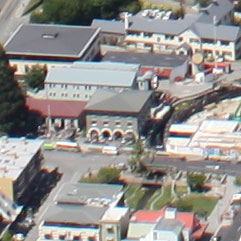 | ||
f5.6, 100 ISO |
f4, 80 ISO |
f8, 100 ISO |
